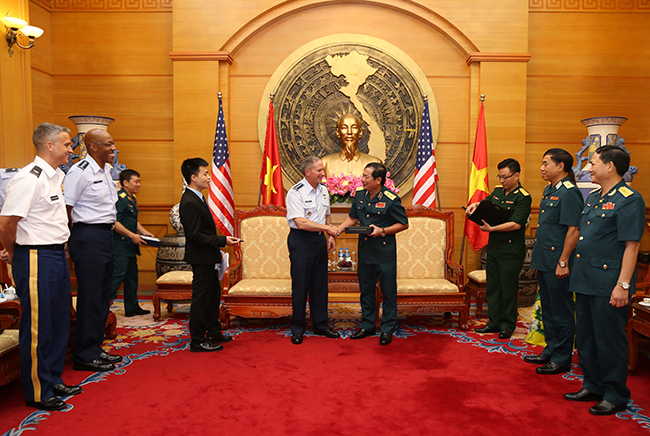
Air Force Chief of Staff Gen. David Goldfein meets with his Vietnamese counterpart, Lt. Gen. Lê Huy V?nh, in front of a golden statue of Ho Chi Minh. Goldfein and Gen. Charles Brown (left) made a historic visit to Hanoi in August.
US Air Force Chief of Staff Gen. David Goldfein and Pacific Air Forces Commander Gen. Charles Q. Brown went to Vietnam in August, visiting a place where their fathers fought and served half a century before.
“I realized I was looking at the exact same picture my dad looked at in the cockpit of his F-4,” said Goldfein, recalling his emotions as his plane approached its destination. “I looked down and saw this big river that was flowing very red with mud and I said, ‘Well, there it is, the Red River Valley,’ as it came into view.”
Brown said his father completed two tours in Vietnam, working special operations intelligence and subsequently as an advisor to a South Vietnamese transportation unit. “As we flew in, I reflected on my memories of my dad leaving home and at such a young age not fully appreciating he’d gone to war,” Brown said.
How times change. The official visit were marked by two-days of cooperative meetings with senior Vietnamese officials. “I wasn’t sure what kind of reception we’d get, given our history between our two countries,” Goldfein conceded. “What was really rewarding was how sincerely warm the reception was.”
Added Brown: “Those that had once been my father’s adversaries were now our partners focused on common security interests.”
Goldfein’s visit marked the first time a US Air Force Chief of Staff came to Vietnam since the war ended. Cooperation has not erased the past, however.
From their hotel in Hanoi, Goldfein and Brown could see the red rooftop of what remains of the notorious Hanoi Hilton, where US prisoners of war were held in brutal conditions. The generals visited the site and stood where US heroes like then-Air Force Col. Bud Day and then-Navy Lt. Cmdr. John McCain were held captive and tortured.
“Standing in one of the concrete cells for just a few moments,” Brown said, “I reflected on the fact that many of our POWs spent not moments, but years in these cells under arduous conditions. It was a very sobering experience.”
